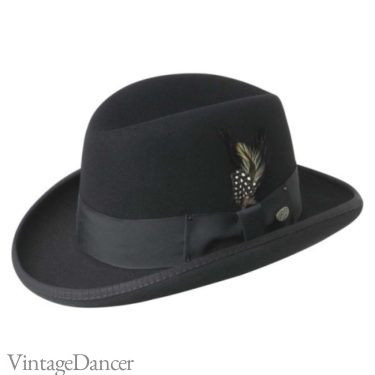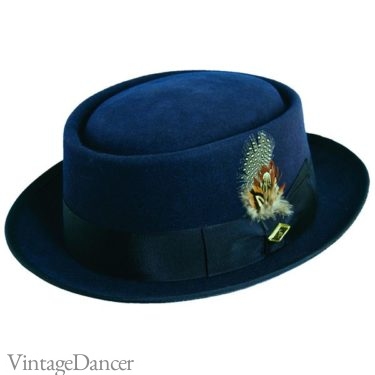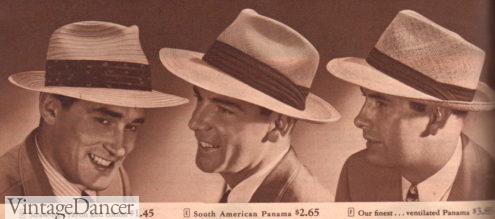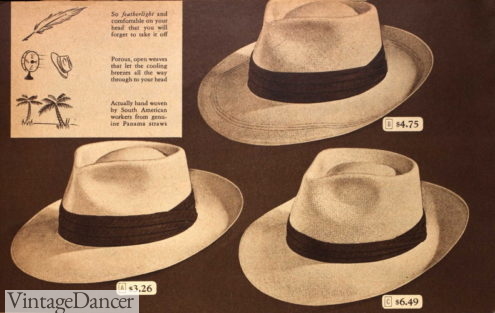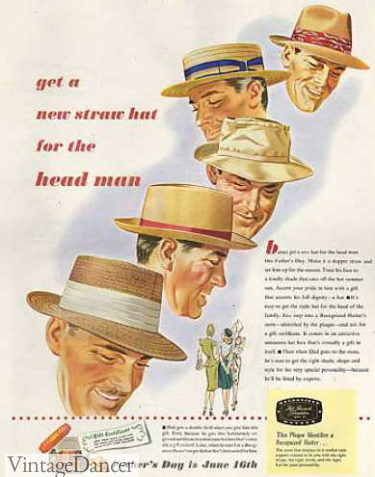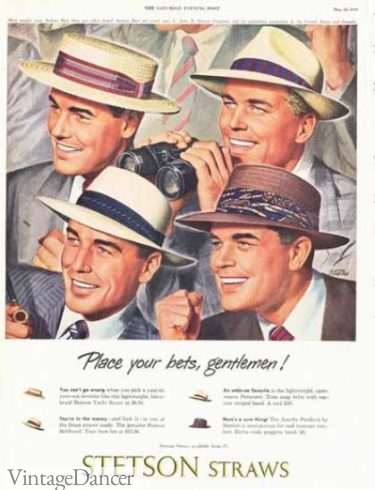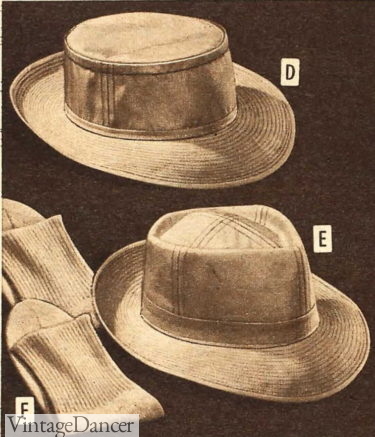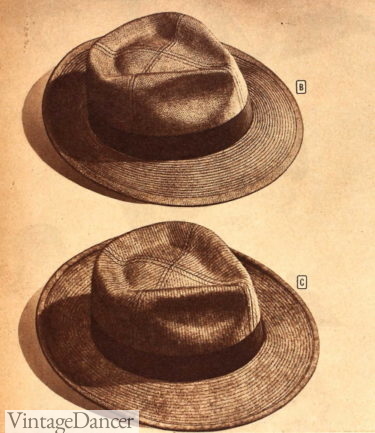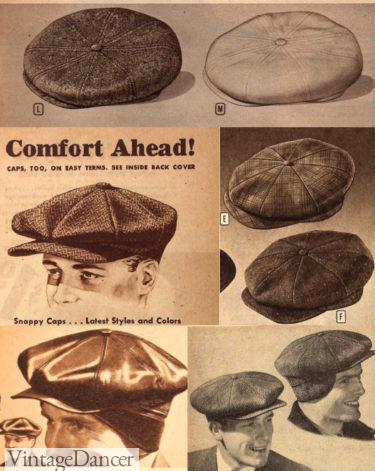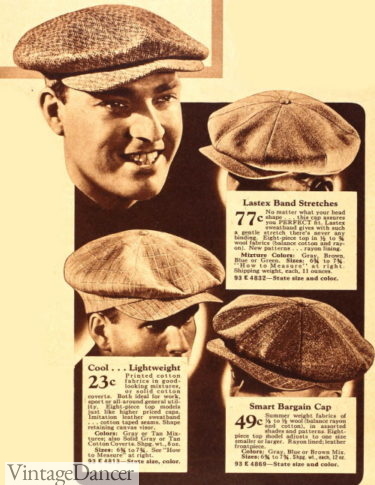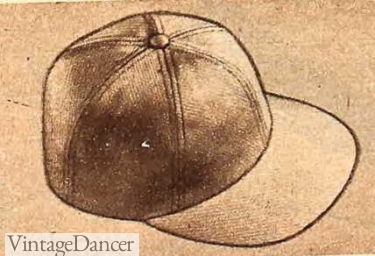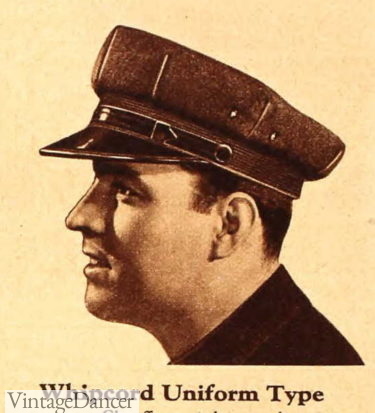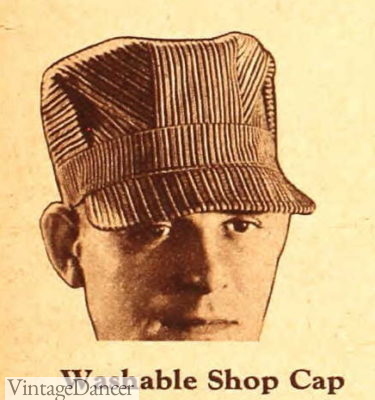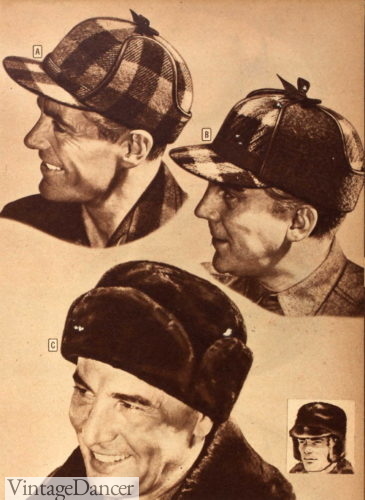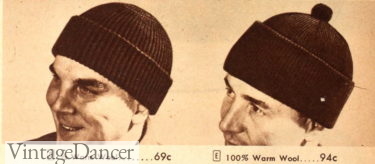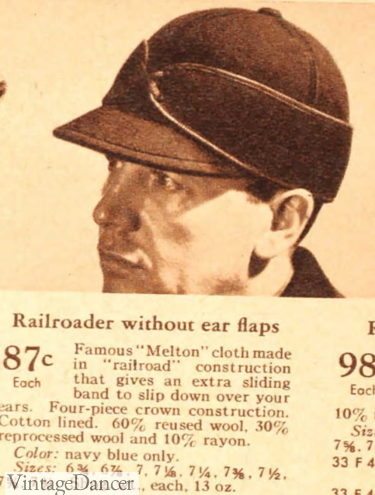A hat wearing gentleman of the 1940s continued the tradition of wearing most styles of hats from the 1930s. The classic fedora, homburg, and flat caps were worn with only subtle adjustments in style. The Derby or bowler was still worn in Britain by some from the generations, but the overall trend was for more casual styles and colors. The newer hat of the 1940s was the Pork Pie, and it carried on in fashion through to the 1950s.
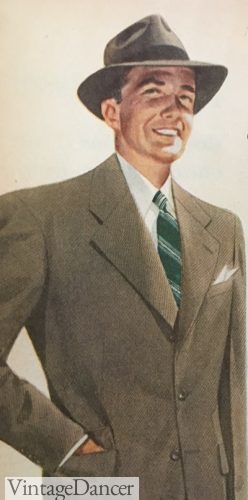
1944 Men’s grey fedora hat with black band- a classic ’40s combination
Stylistically, the main difference between hats of the 1930s, 1940s, and 1950s was how they were worn. Most hats of the ’40s were worn tilted to one side. Hat brims took on many shapes, with the back brim curved upwards being the one common feature among many styles of 1940s men’s hats for sale.
The width of the brim was quite wide in the early ’40s and widened again at the very end of the decade with the middle years reducing a little. The average brim was 2 1/2 inches wide. This was true only in American. The British favored a narrowed fedora hat in the 1940s.
The material was also lighter, especially fur felt, which was no longer stiff but soft and more comfortable to wear. This lighter hat also reduced the cost of material, making them more affordable during the war years.
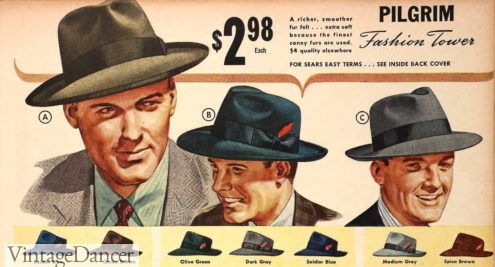
1941 men’s fedora hats
Most men shopped for a hat from a local haberdasher. The shop owner would advise the customer on the shape of hat that suited his face, body build, and fashion style. He would then take a blank hat and shape the crown and brim to perfection.
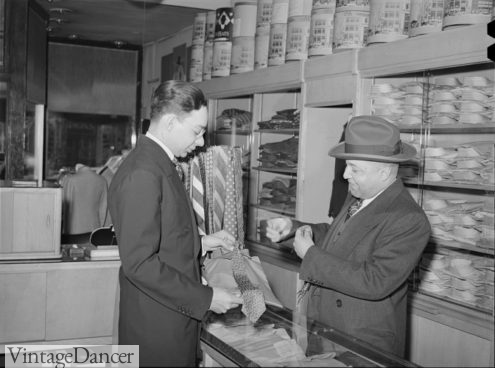
1941 shopping in a menswear store (note the hat boxes on the top shelf)
A hat was an investment — something to be worn with pride, taken care of, and treated with more respect than any other part of his wardrobe. A good straw hat lasted a year or two. Many straw hats only lasted a few months, requiring frequent replacement. Thankfully, they were much cheaper as well.
Unfortunately, hats were beginning to experience a downward trend after the war. Casualness in men’s fashion was becoming more and more common to the point most hat wearing was done for leisure activities, sports, and blue collar work.
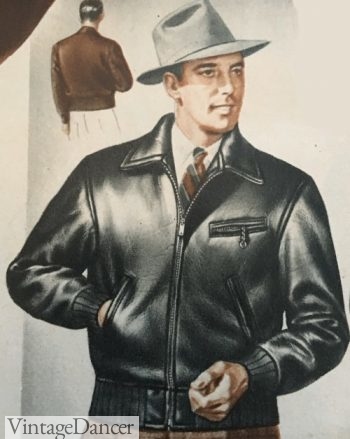
Casualness and traditional hats didn’t seem well paired by the young 1940s men
Business men wore hats, too, as they had done for the last several decades, but the younger generation was not keen on the concept. They had nicely combed hair. Why cover that up with a hat? Or deal with the hassle of storing it, taking it off inside or while driving, and not losing it to a hat stand thief?
The young men complained that they were uncomfortable, giving them headaches, and were perhaps unhealthy, too (hats + sweat = acne). They also cited hat styles were old and boring. A young newspaper writer, Sydney J. Harris, in 1944 said that he and his friends “resented the bland uniformity of the dumb-looking hat.”
The young wanted something completely new, or else nothing at all. They gravitated toward new hats styles, colors and shapes leaving older men to the timeless fedoras and homburgs.
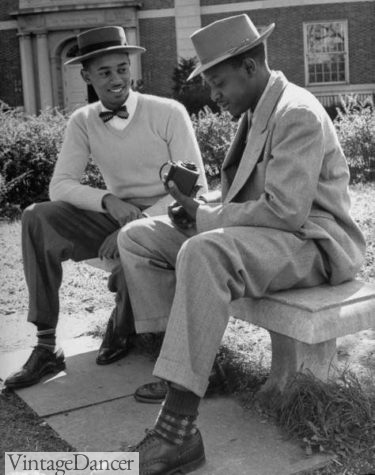
1946 Howard University students wearing porkpie hats
Another reason for hatlessness was improvements to indoor heating and heaters in cars, They made wearing a hat in winter unnecessary. By the late 1940s, only about 40% of men were wearing hats on a daily basis. The rest simply went out without a care in the world.
Since hat wearing isn’t common nowadays, putting on a 1940s hat seems necessary when dressing for a vintage 1940s event. Determining what hat to choose begins with an exploration of 1940s men’s hat styles.
1940s Fedora Hat or Trilby Hat
Most men’s hats were just called felt hats, not by any specific name. Of all the variations, the fedora hat was the most common, and in general most felt hats fit the style of the fedora. It featured a snap brim that curved down in front and up in back.
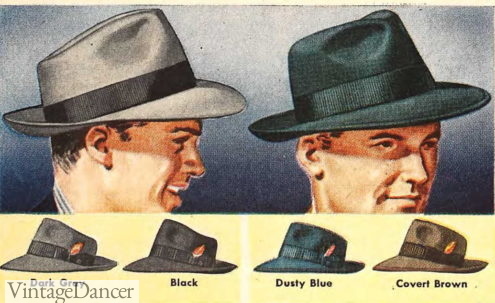
1941 men’ s fedora hat colors: grey, black, blue, brown
The tall center crown had a crease that was either flat or sloped toward the back. The front of the crown featured a pinched indentation on either side. The finish of the felt was usually smooth, but some styles did have a light fur texture and even very heavy fur in cold areas.
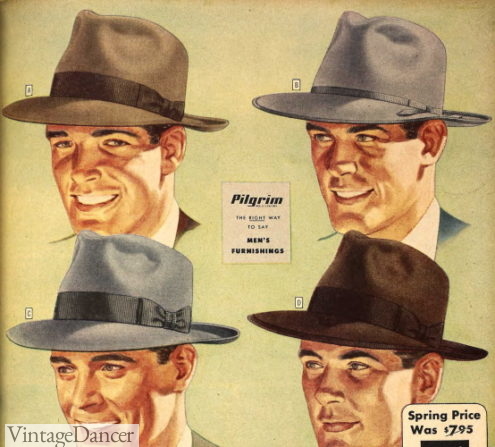
1947 men’s fedora hats- browns and greys
The average brim size was 2-5/8 inches, but brims also came in 2 1/2 and 2 3/4. Small faces needed small brims; larger faces needed wider brims. Crowns were also tall but had shrunk down an inch or so for most of the 1940s.
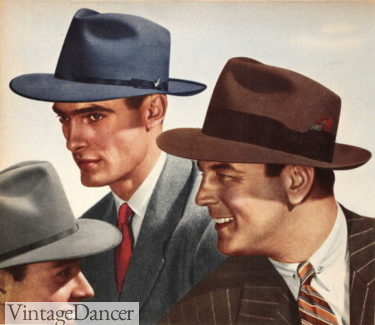
1943 men’s fedora hats: blue, brown and grey
- Colors: Blue, Green, Tan, Grey, Brown
- Materials: Fur felt, cotton cloth, or light woven straws
- Shape : Tall pinch-front crowns with a center crease that was either flat-topped or angled to the back (sloped)
- Brim: Turned up at the back, flat around front and sides or a brim turned down in front and up at the sides and back
- Band: Wide petersham ribbon band in the same color or shade as the hat body. A solid black band on any color of hat was also very common. A flat ribbon bow fastened on one side with a feather was added to some. A thin band with narrow bow was another option for dapper young called the “southwest flight” model. A thick leather band was worn on “western” style fedoras.
- Style: Worn at an angle to one side (usually the right side).
- Worn with: Everything, business to casual. It was the most versatile hat.
- Best Starter Hat: Fredrick Fedora (2.5″ brim, many colors). Wide brim fedora hats 2 5/8″
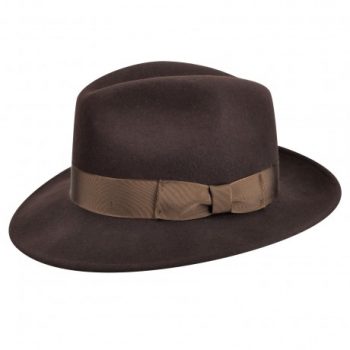
This classic fedora from Hats.com is available in a selection of colors.
1940s Homburg Hat
The homburg hat gained popularity beginning at the turn of the century and in the 1920s. It was a more formal style than the fedora, with a stiff fur felt, deep center dent, wide band with bow, and rolled brim edge. It was only worn with nice business suits by professional men, politicians, dandies, and some wealthy gangsters.
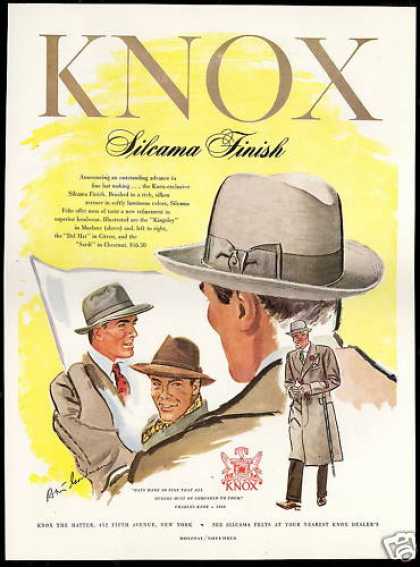
1942-43 Men’s winter fedora hats
Winston Churchill, was a well know wearer of the grey Homburg in the 1940s hat although he said he didn’t like it. Anthony Eden wore a homburg hat in the 1930s and 1940s. He was known as a smart dresser and his hat choice lent an of confidence and authority. The public associated him with the Homburg hat to the point it became know as the “Eden hat.”
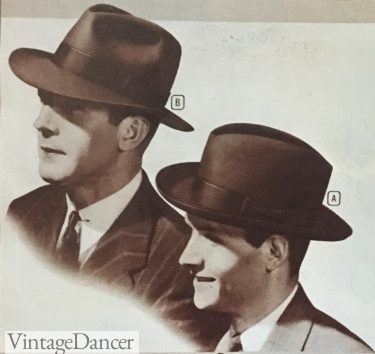
1947 men’s homburg hats (lower)
Still popular in the early 1950s, US President Dwight Eisenhower wore a black homburg hat at his 1953 inauguration. But it wasn’t political men that made the Homburg famous. Instead, the 1972 Godfather movie depicting Al Pacino’s character wearing a Homburg hat brought the Homburg out of the history books and back into mainstream fashion.
Because of that movie the public today tends to believe the Homburg was a common 1940s hat, when in fact it was a novelty.
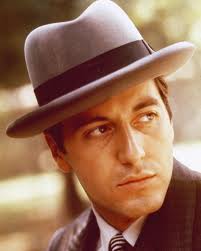
Homburg Hat worn in The God Father
- Colors: Dark Blue, Dark Brown, Grey, Black.
- Material: Fur felt.
- Shape: Tall crown with moderate center crease.
- Brim: Curled edges on the side and only slightly curled up at the front and back. Brims were wider/less curled than the previous decades.
- Band: Black Petersham ribbon band and optional binding on the brim or matching band to hat.
- Style: Worn pulled forward and down slightly on the forehead.
- Best Starter Hat: Baily Godfather Homburg or Scala Springfield (Remove the feathers)
1940s Porkpie Hat
The pork pie was an oval flat top hat with a 2 to 4 inch round brim that was also flat or with slightly curled up brim. A crease around the flat top on felt hats is what sets it apart from other telescope crown hats. Pork Pie hats became popular on college campuses, first emerging in a khaki summer color with colorful band. Summer hats usually had a crown that was a little taller in the front with a mild slope to the back.
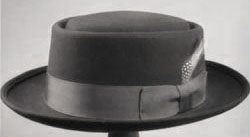
1940s Pork pie hat
Pork Pie hats are also associated with Jazz music, artists, and those urban rebels, the Zoot Suiters. It was not a hat for the mainstream, but one for the subcultures and fashion leaders.
Frank Lloyd wright was photographed in his tan pork pie hat on many occasions throughout his life. His pork pie had a thin hat band.
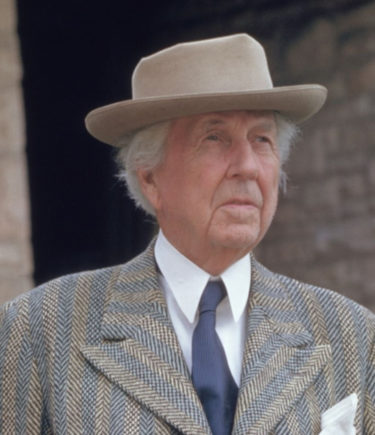
1947 Frank Lloyd Wrights wears a tan Pork Pie
Lester Young, jazz musician, made his wide brim pork pie hat with feathers on one side, part of his signature fashion. Thelonious Monk , Jazz pianist, had a vast hat collection including the stringy brim Pork Pie hats (back brim was turned up, front down.)
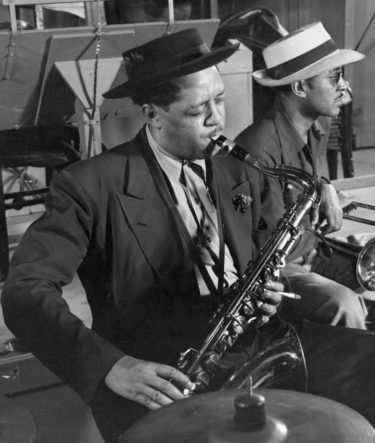
Lester Young wears a pork pie hat. His neighbor wears a similar telescope crown stringy brim straw hat.
Zoot Suit wearing youth choose the very wide, 4 inch, brim pork pie hat in bright colors to coordinate with their brightly colored suits. They had feathers on one side too.
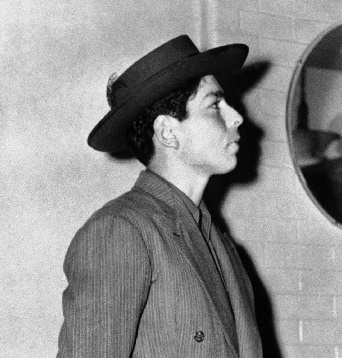
1943 Zoot Suit youth wearing a wide porkpie hat
- Colors: Black and Brown year round, Khaki for summer. Bright colors to match Zoot Suits.
- Material: Fur felt, straw, or cotton cloth for summer styles.
- Shape: Short, oval flat top with deep crease around oval.
- Brim: Wide slightly curled up brim all around.
- Band: Thin leather band matching color of the hat or wide petersham ribbon with flat bow. For summer, colorful paid patterns appeared on the band. Feathers were usually added from the mid 40s onward.
- Style: Worn at an angle, tilted back, or straight on.
- Worn with: Casual clothing in summer, business attire for felt models.
- Best Starter Hat: Bollman 1940s Pork Pie (Black), Kingpin Chemist and Danger (Many Colors)
1940s Straw Hats
From May to September, men wore summer hats made of straw. They came in all the shapes that felt hats did and in a variety of weave materials such as coconut palm, sennit straw, watersilk palm, cocoa baku, banana palm, and hanoki.
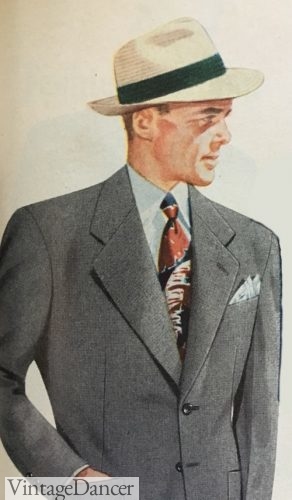
1944 Men’s summer straw fedora hat with green pleated band
Some classic shapes were boater, Panama, telescope pork pie, fedora, and sloped fedora. Weaves could be finely woven or a touch more open for breathability.
Hat bands were pleated wide or medium widths. The most basic options were blue or tan bands with lighter hat colors. The the move to the Bold Look in the late 1940s added brighter band color and some patterns as well.
- 1944 straw hats with blue or brown brands
- 1946 panama straws, fedora shape
Most straw colors were light ivory to khaki. In the late 1940s the coco colored straw hat started to come into fashion.
- Late 40s straw hats
- 1959 straw hats
- Shape: The 1940s fedora, pork pie, Panama and boater came in straw hat varieties. Crowns were usually flat but could have a center crease, C shape or pinch front like a fedora.
- Color: Light khaki straw, medium yellow straw, and dark coco straws and every shade in between.
- Brim: Wide, round, brim that shaped downward all around.
- Band: A wide silk or cotton pleated band in a number of solid colors. Bold combinations, like pink and blue, were popular. Tropical or native prints were trendy as resort wear.
- Style: Worn centered on the head. Only the straw fedoras were angled.
- Best Hats: Stetson Retro Panama, Straw Boater, Panama fedora or pork pie
1940s Cloth Hats
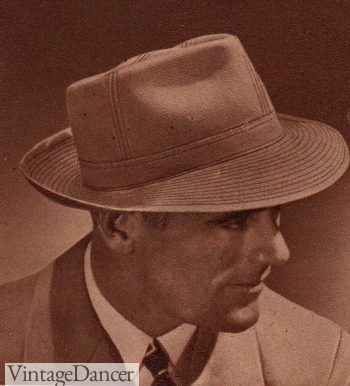
1944 Cotton twill fedora bucket hat
A casual, sporty summer or work hat was the cloth “knock-about” hat. It was first worn on golf courses before being picked up by young college kids and men living in the country. The fedora shape had a floppy snap brim and side air vents. The porkpie shape had a flat oval crown and a flat or snap brim.
Popular colors were khaki, green, grey, blue, and brown. As a work hat, it often matched the color of the work uniform. They were made of cotton twill, rayon, gabardine, herringbone wool or corduroy.
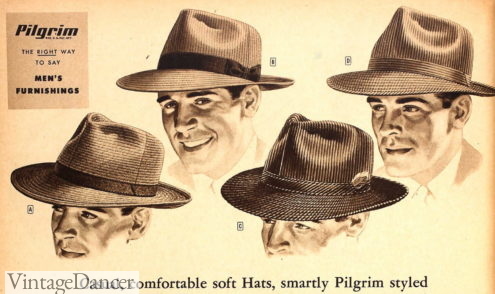
1946 men’s cloth hats
In winter, the hat came in a lined cotton twill with attached ear flaps. Rainproof versions were made of oil cloth.
These hats are difficult to find today. Some “Outback” or “Safari” and Bucket style hats might work. Try the Dobbs Urban cloth hat or linen hat for a modern take (narrow brim.)
- 1945 porkpie and fedora cloth hats
- 1944 herringbone wool and stitched cotton twill winter hats
Western Hats
A few classic western hats were still being worn in the 1940s. The Carlsbad hat with a high 7 inch crown with forward indentation and 4 inch curled brim was the biggest. The Columbia was a dressier western hat with 5 3/4 inch crown, center dent, curled brim and narrow ribbon hat band. Both came in black, tan or sand colors. Find classic Western fur felt hats at Hat Country.
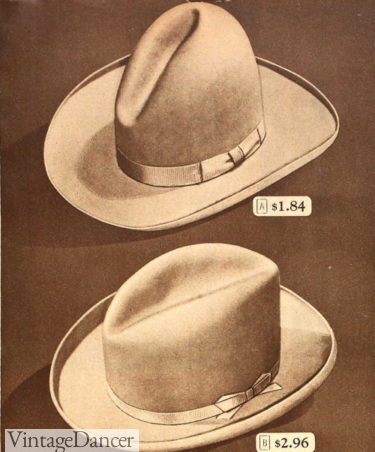
1946 Carlsbad and Columbia hat
Big straw hats (Sombrero or Carlsbad) , straw hats with leather visors (Cloth hat shape), coolie (Chinese) and pith helmets (called a sun hat) were other hats worn by farmers and ranchers. They could be picked up at the local five and dime shop for very little money.
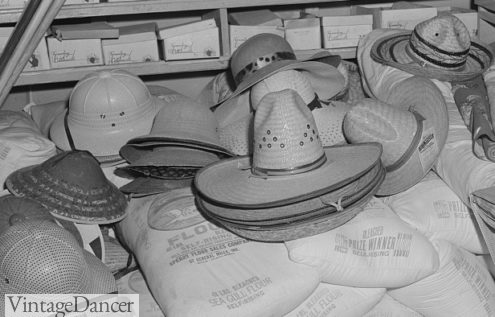
1941, work hats for sale inside a local shop in Georgia.
Sport Caps
Another workwear and sportswear hat was the classic cap. Just called a cap, dress cap or work cap in the 1940s, it now has many names today like flat cap, newsboy, ivy cap, Big Apple cap, and many more.
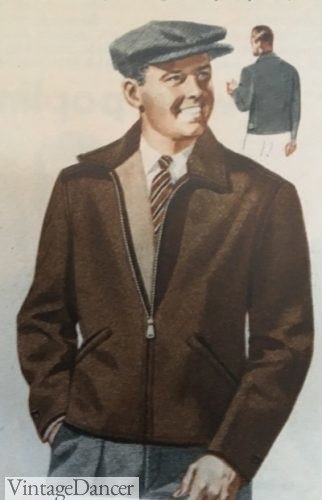
Grey Tweed Cap
The traditional cap was made of 8 triangle panels sewn together in a circle and snapped to a short front visor. It could also be sewn from one piece of material, called a one piece crown.
Caps were rather flat but still wide in appearance, unlike the very full 1920s version, and they came in tweed, cotton gabardine, leather, corduroy, or wool. Solid colors such as blue, grey, and tan were for summer.
In winter, tweed-like blends of herringbone, speckled grey, dark blue and brown were common. Many caps had fold down ear flaps to keep out the cold.
- 1940s cap varieties
- 1940 one-piece and men’s 8 panel caps
Flat caps were worn with casual clothing, sporty attire, driving, and working labor jobs. They were still worn on golf courses and other outdoor sports, but otherwise were mostly associated with working classes.
Best Hats: Tweed Cap (anything called an 8 panel cap, Gatsby cap, or newsboy cap is usually the right style)
Work Hats
For working occupations men wore a few varieties of caps or hats, depending on job:
- Baseball cap – A basic cotton visor cap for all informal jobs
- Uniform cap (yacht style) for police, chauffer’s, repair men- anyone in a formal Uniform
- Shop cap for railroad workers, mechanics, factory men
Other styles of caps were worn for rugged outdoor sports, like hunting and fishing, or for extremely cold climates. These hats had a visor like a baseball cap and ear flaps that tied up on top of the head or over the visor when not in use. They were fully lined in warm cotton or shearling wool. The outside fabrics was usually corduroy, leather or a plaid blanket cloth. Beige, brown, black, dark blue, or red plaid were common colors.
The knit beanie cap or the rabbit or seal fur cap with fold down flaps were the best for cold winters.
- 1944 tie up caps and fur cap
- 1944 knit caps
- 1943 Railroader cap
Buying 1940s Hats
Whenever possible, buy a vintage 1940s men’s hat (eBay, Etsy or Facebook groups). They can be pricey to buy, but well worth it if you want the most authentic 1940s hat. Otherwise, new men’s hats continue to be made in vintage styles. Quality fedoras often come with flexible brims so that you can change the brim shape to match that of 1940s style.
Shop now 1940s Men’s Hats
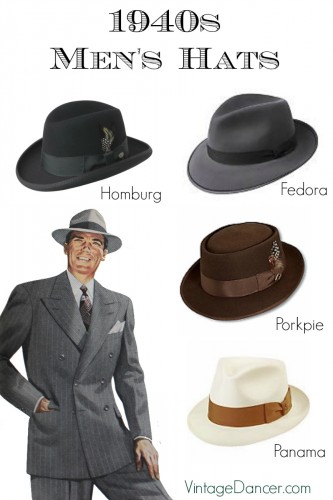
1940s Men’s Hats-Buy here
You, too, can buy a new 1940s style men’s hat with or without a shaped brim. Most modern fedora hats have smaller snap brims (2 inches or less) that were not worn in the 1940s. They are also usually black, which was not a very popular color, even for gangsters. Dark grey with a black band is your best choice to wear with suits. Brown is good for brown suits or semi-casual clothing. You could also stand out with a blue or green fedora hat.
Read more about men’s vintage hat history
- 1900s Men’s Hats
- 1910s Men’s Hats
- 1920s Men’s Hats
- 1930s Men’s Hats
- 1950s Men’s Hats
- 1960s Men’s Hats
Debbie Sessions has been teaching fashion history and helping people dress for vintage themed events since 2009. She has turned a hobby into VintageDancer.com with hundreds of well researched articles and hand picked links to vintage inspired clothing online. She aims to make dressing accurately (or not) an affordable option for all. Oh, and she dances too.
